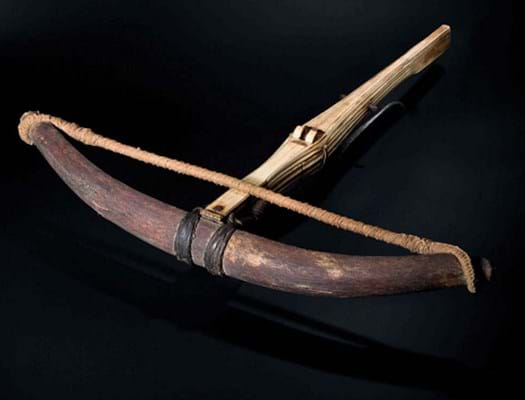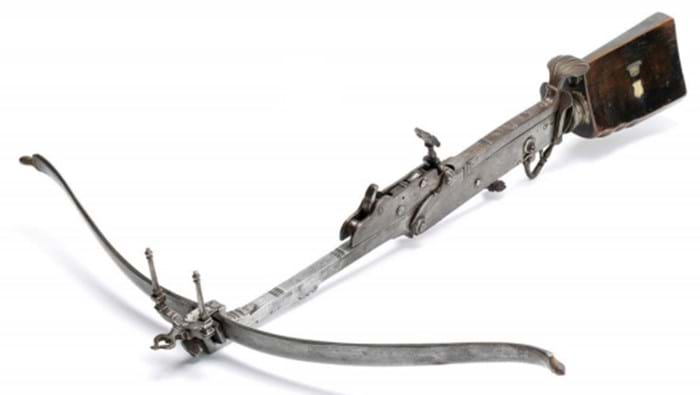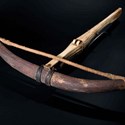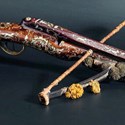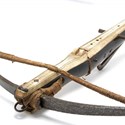Hammer highlights
£1 = €1.1
THOUGH it has sometimes had a bad press, the crossbow remains one of the most successful and long-lived of all the weapons in the armoury.
So fearsome was it considered in the medieval period that in 1139 Innocent II issued a papal bull in an attempt to forbid its use. Though they were later eclipsed on the battlefield by the longbow and the gun, they continued to be used well into the 19th century by hunters who appreciated that they were not only effective, but also silent.
Recent sales have produced crossbows from nearly all periods of their history as discussed here.
Medieval survivor
Survivors from the medieval period are so rare as to be almost unobtainable, but Hermann Historica’s (23% buyer’s premium) autumn sales series in Munich did include a fine and rare example of c.1500 with its original composition bow of horn and animal sinew.
By combining the high compressive strength of horn and the enormous tensile strength of sinew, early bow-makers were able to create powerful weapons quite capable of piercing armour at long range.
The layers of bone and sinew were bound together with animal glue and protected from the elements by a layer of birch bark, and the example in the Munich sale of October 24-November 5 retained traces of this original covering. The stock (or tiller) was entirely veneered in polished and fluted staghorn plates, indicating a weapon of superior quality, and it retained its original firing mechanism and iron trigger lever. It sold for €16,000 (£14,550).
A high-quality German crossbow of the late 16th century, with a provenance to the Royal House of Hanover, having been sold by Sotheby’s at Schloss Marienburg in October 2005, again entirely encased in engraved bone plates and with the heavy steel bow that superseded the horn and sinew composite, reached €7500 (£6820).
The Hermann Historica sale also included two very fine examples of the continued development of the crossbow in the 18th century, with two rare and interesting stonebows. Designed to fire pellets or lead balls, these weapons were sophisticated catapults which drew heavily on the style and developing technology of firearms.
Of considerable technical interest was a walnut-stocked bow, elaborately inlaid with engraved steel decoration and fitted with a brasslined rifled barrel fed with bullets from a wooden magazine above.
Made in Hanover in the second half of the 18th century, this rarity sold for €7500 (£6820) and was only eclipsed by an even rarer survivor of the period, a German pistol-crossbow with an ivory-lined wooden barrel.
Stocked in fine walnut like a typical pistol of the 1760s, this exceptional weapon was decorated with a continuous pattern of scrolls and hunting scenes in engraved bone and mother-of-pearl. It sold for €13,000 (£11,820).
Crossbows designed to fire bullets rather than bolts had been popular hunting weapons for small game long before these sophisticated 18th century weapons appeared.
Air rifle equivalent
At Thomas Del Mar’s (24% buyer’s premium) December 7 sale in London, an early 18th century German all-steel stonebow sold for £1000. Known as a Schnepper or snapper, this type of bow, silent and deadly at close range, must have been the 17th and 18th century equivalent of the air rifle, which long enjoyed a dubious reputation as the weapon of choice for assassins and poachers before becoming the plaything of small boys the world over.
The December Del Mar sale included several air rifles, including examples disguised as walking sticks (see story above).
Pump-up reservoirs with sufficient pressure to power several shots quickly became the norm, but the earliest air guns appear to have operated on a bellows system where a strong spring acted on a pair of bellows housed in the butt of the rifle.
When the trigger was squeezed the spring was released, forcing air from the bellows into the barrel and discharging the projectile.
Though obsolete elsewhere, this bellows system, which had to be cocked with a lever before each shot, remained popular in central Europe for target shooting.
In the Del Mar sale an early 19th century Austrian breech-loading bellows gun of .300 calibre by Jakob Kresko of Gratz reached £1900.


